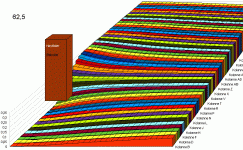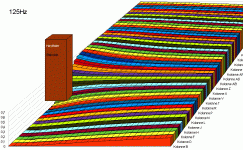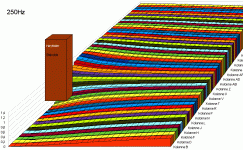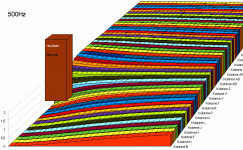One of my main focus points has been controlling loudspeaker dispersion. Solutions like dipole and horn are well known technologies, but the horns are not delivering contonous 4 pi dispersion at very wide ranges. Further they usually suffer from internal reflections and last, but definately not least, lower midrange horns are big. Dipole solutions are very good, except from two things, the repeating peaks and dips, and off course, the negative rear output.
Since the release of Gaia there are no doubt that controlled dispersion contributes to the focus of the soundstage and dynamic presentation, but they have lower midrange horn openings of 1,7 square meters each.
This new solution can be realized in very small form factors. 125Hz can be controlled in a 20cm by 30cm by 20cm cube, which fits in as a midrange section in virtually any speaker.
It is partially inspired by the cardioid method used for professional audio, but it has far more control, can do narrower dispersion and works effectively over a wider range.
I have made some very simplified simmulations of what happens behind the speakers. This does not fully show what happens on the sides and in front of the speakers. There are at least 3-4 important factors that are not included.
This shows a pretty constant dispersion pattern from 62,5 to 500Hz. By careful dimensioning and selection of drivers it is probably no problem to get the dispersion pattern to stay constant up to around 2kHz, and from there and up it is quite easy to control the dispersion perfectly within a 20cm wide baffel.
The simmulations can be read as this:
Lower left corner is about 30cm behind the speaker. The lower right corner is 60cm to the right from the speakers axis. The total length of the diagram is 100cm. The height of the graph shows the level of sound pressure at that particular frequency at any point in the 100 by 60cm space.
Frequencies in between does not vary in any repeating pattern like a typical dipole.
Since the release of Gaia there are no doubt that controlled dispersion contributes to the focus of the soundstage and dynamic presentation, but they have lower midrange horn openings of 1,7 square meters each.
This new solution can be realized in very small form factors. 125Hz can be controlled in a 20cm by 30cm by 20cm cube, which fits in as a midrange section in virtually any speaker.
It is partially inspired by the cardioid method used for professional audio, but it has far more control, can do narrower dispersion and works effectively over a wider range.
I have made some very simplified simmulations of what happens behind the speakers. This does not fully show what happens on the sides and in front of the speakers. There are at least 3-4 important factors that are not included.
This shows a pretty constant dispersion pattern from 62,5 to 500Hz. By careful dimensioning and selection of drivers it is probably no problem to get the dispersion pattern to stay constant up to around 2kHz, and from there and up it is quite easy to control the dispersion perfectly within a 20cm wide baffel.
The simmulations can be read as this:
Lower left corner is about 30cm behind the speaker. The lower right corner is 60cm to the right from the speakers axis. The total length of the diagram is 100cm. The height of the graph shows the level of sound pressure at that particular frequency at any point in the 100 by 60cm space.
Frequencies in between does not vary in any repeating pattern like a typical dipole.
Attachments
hi mate im about to builde a new set of cabs for my troels gravesen ekta grande speakers and im very interested in this .does the cube you speak of form a seperate enclosure for the mid inside the main cabs .can i have some more details please . many thanks regards sheafer
It can be shaped differently, but you will need some not so straight forward signal processing.
I will keep the details to myself so far, but I will present some measurements as soon as I have a prototype for testing.
I will keep the details to myself so far, but I will present some measurements as soon as I have a prototype for testing.
It sounds fascinating.
But, since this is a "diyaudio" forum, how can we learn something and "DIY"?
Snickers-is said:It can be shaped differently, but you will need some not so straight forward signal processing.
...
But, since this is a "diyaudio" forum, how can we learn something and "DIY"?
- Status
- Not open for further replies.
- Home
- Loudspeakers
- Multi-Way
- New way of controlling mid range dispersion.



